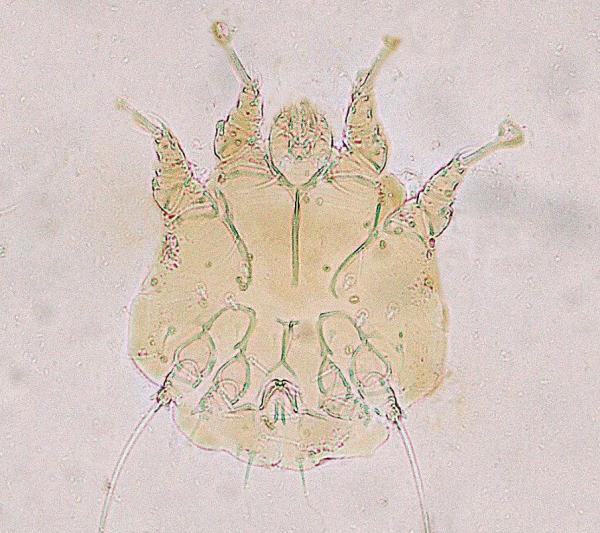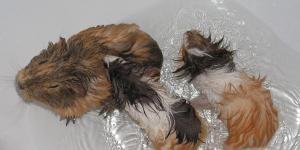Notoedric Mange in Cats (Notoedres Cati) - Symptoms and Treatment



See files for Cats
In this AnimalWised article, we are going to talk about notoedric mange, a type of scabies caused by the Notoedres cati mite. This mite is a parasite and it's effect on its host can lead to intense itching and acute skin problems. When this host is your beloved cat, then you will want to know what you can do to help alleviate symptoms and treat the scabies. While notoedric mange is not a very common type of mange in cats, it is both very contagious and zoonotic. Zoonotic diseases are those which can be transferred to humans. This is one of the many reasons we need to go to the veterinarian immediately if we suspect our cat has notoedric mange. AnimalWised looks in the symptoms of notoedric mange in cats as well as the possible treatment options available.
Notoedres cati: characteristics and life cycle
The Notoedres cati is a mite from the family Sarcoptidae. Its life cycle will be carried out while on its feline host and lasts between one and three weeks. It feeds on the epithelium of the skin, known as the epidermis. Males and females copulate on the skin of a cat. After copulation, the female will dig into skin, excavating subcutaneous tunnels in the skin. They feed on fluids which ooze and tissue they damage as they burrow into the skin.
In the burrows beneath the epidermis, the Notoedres cati mites lay their eggs. When these eggs hatch, out come the larvae which continue to feed on the epithelium and turn into nymphs. These are mites in the stage before they become adult. The nymphs eventually develop into adult mites and the life cycle is complete, ready to continue over again.
As for the morphology of Notoedres cati, they are sexually dimorphic. This means they male and female specimens are different in appearance. The adult mites are smaller and measure about 0.15-0.3 mm. Their shape is ovoid and they have short, thick legs. At the end of these legs are a kind of claw which allows them to burrow into the skin so effectively.

Is notoedric mange contagious?
Notoedres cati causes a dermatitis that is very contagious and is transmitted by both direct and indirect contact. In this way, a cat can become infected after touching and interacting with objects an infested cat has previously touched. This means they can become infested themselves if they have interacted with objects previously touched by an infested cat. Even walking in the same space of an infected cat might lead to infestation.
Can notoedric mange spread to dogs?
Cases of Notoedres cati have been found in dogs, but it is not common. With the relevant treatment and cleaning measures, no other member of a household will likely be infected, even if it is possible. The exception is other cats. If another feline comes in contact, they are very likely to become infected. While it is possible to transfer to humans, it will ve unlikely. This is because the mite prefers cats.
Symptoms and diagnosis of notoedric mange in cats
More than any other part of the body, the disease will affect the head. However, the mites can colonize any part of the cat, including the front legs and perianal region. Additionally, this mite stands out above others for the intense itching which comes along with an infestation. This is due to the subcutaneous nature of their burrowing, unlike other mites which remain on top of the cat's skin.
The skin of an affected area on a cat will look thickened, hairless and crusted. These types of injury are those which will make a veterinarian suspect the presence of Notoedres cati mites. The professional can confirm diagnosis of notoedric mange in cats by taking a skin sample and looking for either the mite or their eggs under a microscope. The young or weakened cats are more likely to be affected since their immune system will not be as strong.
We need to ensure we don't confuse this pathology with other types of scabies, such as demodectic mange. This is a very rare type of scabies in cats which usually affects the head and neck. The result of this type of mange is usually alopecia and otitis in the ears. It is a very rare skin disease in cats which can extend to the rest of the body. When a cat is suspected of this type of infestation, they will use a skin sample to look mites (usually Demodex cati) or their eggs. Without these tests, many different types of mage will be confused for another.

Treatment of notoedric mange
The treatment of notoedric mange in cats can be either topical or systemic. Ivermectin for cats is a classic treatment in the fight against notoedric mange. There also other effective and safe options on the market, such as pipettes with medicines like selamectin. You can also give treatment such as milbemycin oxime which comes in pill form. This can be difficult for cats to swallow.
It is very important treatment of notoedric mange in cats is immediate. The prescription and advice given by the vet needs to be followed closely for both success and to avoid contagion. Cats can die from notoedric mange if it is left untreated. Medication must also be administered to all cats in the same environment and the environment needs to be thoroughly disinfected.
Can Notoedres cati spread to humans?
Yes, it is possible that notoedric mange in cats could be transmitted to humans. However, the transfer if the mites will usually only be transitory. They may be able to survive on the skin of humans, but they will not be able to reproduce. In this way, it is a self-limiting process. In people, Notoedres cati can only cause slight dermatitis. Treating affected cats will be the best way to solve the problem, but you should get a check up nonetheless.
Other common mites in cats
The most common mite in cats is the Otodectes cynotis, a common ear mite which also affects the rest of the head and face area. In addition, Cheyletiella and Demodex gatoi are common. To make a quick diagnosis and start the treatment of scabies in cats, it nis necessary to go to the veterinarian when symptoms occur. These signs and symptoms usually manifest as scratching, skin lesions, skin thickening, localized hair loss and others.
This article is purely informative. AnimalWised does not have the authority to prescribe any veterinary treatment or create a diagnosis. We invite you to take your pet to the veterinarian if they are suffering from any condition or pain.
If you want to read similar articles to Notoedric Mange in Cats (Notoedres Cati) - Symptoms and Treatment, we recommend you visit our Parasitic diseases category.
- ESCCAP (2018). Ectoparasite control in dogs and cats . ESCCAP Guide Nº3.
- Fraile Ocaña, C. Feline dermatoses in communities . CV "El Burgo", Las Rozas, Madrid. Department of Animal Pathology I.







